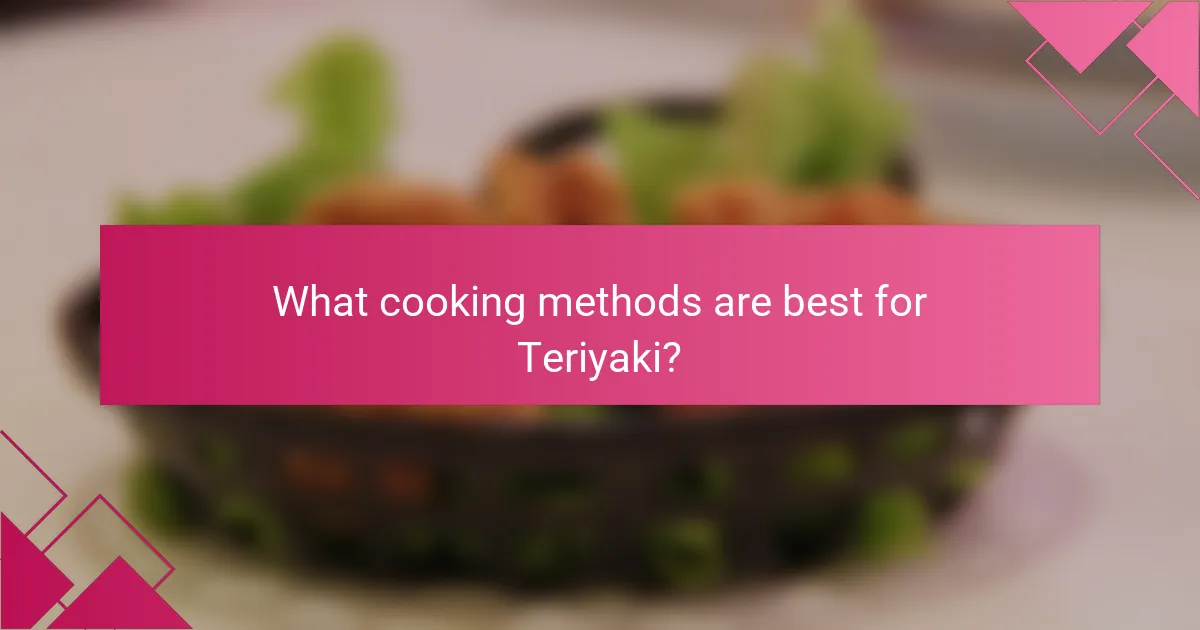
What is Teriyaki?
Teriyaki is a Japanese cooking technique that involves grilling or broiling food with a glaze of soy sauce, sake, and sugar. This method creates a sweet and savory flavor profile. The term “teriyaki” refers to both the cooking style and the sauce used. Teriyaki sauce typically includes ingredients like mirin and sesame oil. This cooking style is commonly applied to meats, fish, and vegetables. Teriyaki has its origins in Japan, dating back to the Edo period. It has become popular worldwide, often associated with Japanese cuisine. The combination of flavors makes it a favorite in many dishes.
How is Teriyaki traditionally prepared?
Teriyaki is traditionally prepared by marinating meat, typically chicken, beef, or fish, in a mixture of soy sauce, sake, mirin, and sugar. The marinade is allowed to infuse the meat for a period, enhancing its flavor. After marination, the meat is grilled or broiled until cooked through. This cooking method caramelizes the sugars in the marinade, creating a glossy finish. Traditionally, teriyaki is served with steamed rice and vegetables. This preparation method has roots in Japanese cuisine, where teriyaki means “to grill” and “shine.” The balance of sweet and savory flavors is a hallmark of authentic teriyaki dishes.
What are the essential ingredients in Teriyaki sauce?
The essential ingredients in Teriyaki sauce are soy sauce, mirin, sake, and sugar. Soy sauce provides the salty and umami flavor. Mirin adds sweetness and depth. Sake contributes a unique flavor profile. Sugar balances the saltiness and enhances the sweetness. These ingredients combine to create the distinct taste of Teriyaki sauce.
How does the cooking process influence the flavor of Teriyaki?
The cooking process significantly influences the flavor of Teriyaki. Cooking methods such as grilling, broiling, or sautéing enhance the caramelization of sugars in the marinade. This caramelization adds a rich, sweet, and slightly smoky flavor. Additionally, the Maillard reaction occurs during high-heat cooking, creating complex flavor compounds. The duration of cooking affects moisture retention, impacting the overall taste and texture. Overcooking can lead to dryness, diminishing the flavor profile. Conversely, proper cooking maintains the balance between sweetness and umami. Thus, the cooking process is crucial in developing the distinct taste of Teriyaki.
What variations of Teriyaki exist?
Teriyaki has several variations, each with unique characteristics. Traditional teriyaki is a Japanese cooking technique involving grilling or broiling meat with a glaze of soy sauce, mirin, and sugar. Yakiniku teriyaki features grilled beef, while chicken teriyaki uses chicken as the primary protein. Salmon teriyaki is a popular seafood variant. There are also regional variations, such as Hawaiian teriyaki, which incorporates local flavors like pineapple. Additionally, vegetarian teriyaki uses tofu or vegetables as substitutes for meat. Each variation reflects different cultural influences and ingredient preferences.
What are the regional differences in Teriyaki recipes?
Regional differences in Teriyaki recipes include variations in ingredients and preparation methods. In Japan, traditional Teriyaki often uses soy sauce, mirin, and sake. The focus is on a balanced, savory-sweet flavor. In contrast, American versions may incorporate brown sugar and additional spices for a sweeter profile.
Hawaiian Teriyaki features tropical ingredients like pineapple juice, adding a fruity element. Other regions might adapt Teriyaki to local tastes, using different meats or vegetables. These adaptations reflect cultural influences and ingredient availability, showcasing the versatility of Teriyaki across cuisines.
How do different proteins alter the Teriyaki experience?
Different proteins significantly alter the Teriyaki experience through their unique flavors and textures. Chicken, for instance, absorbs the marinade well, resulting in a tender and juicy dish. Beef offers a rich, hearty flavor that complements the sweetness of the sauce. Fish, such as salmon, provides a delicate texture and a subtle taste that enhances the overall experience. Tofu, as a vegetarian option, absorbs the marinade effectively, adding a unique plant-based flavor. Each protein type interacts with the Teriyaki sauce differently, impacting the dish’s overall taste and mouthfeel. The cooking method also influences the final outcome, with grilling adding a smoky flavor while stir-frying enhances the sauce’s stickiness.

What are the best Marinade Recipes for Teriyaki?
The best marinade recipes for teriyaki include a combination of soy sauce, mirin, sake, and sugar. A classic recipe uses 1 cup of soy sauce, 1/2 cup of mirin, 1/4 cup of sake, and 1/4 cup of sugar. Another popular variation adds garlic and ginger for extra flavor. A simple marinade can consist of 1/2 cup soy sauce, 1/4 cup honey, and 1 tablespoon of sesame oil. Each of these recipes creates a rich, savory flavor profile. Teriyaki marinades are traditionally used for meats like chicken, beef, and fish. Marinating for at least 30 minutes enhances the flavor. For best results, marinate overnight in the refrigerator.
How can I create a basic Teriyaki marinade?
To create a basic Teriyaki marinade, combine soy sauce, sake, and mirin in equal parts. Use about ¼ cup of each ingredient for a small batch. Add sugar to taste, typically around 2 tablespoons. Stir the mixture until the sugar dissolves completely. For added flavor, include minced garlic and ginger. Let the marinade sit for at least 30 minutes before using. This ensures that the flavors meld together effectively. Teriyaki marinade is versatile and can enhance various proteins and vegetables.
What ingredients are needed for a classic Teriyaki marinade?
A classic Teriyaki marinade requires soy sauce, sake, mirin, and sugar. Soy sauce provides the salty and umami flavor. Sake adds depth and a touch of sweetness. Mirin contributes additional sweetness and complexity. Sugar balances the flavors and enhances caramelization during cooking. These ingredients are essential for achieving the signature taste of Teriyaki.
How long should I marinate my protein for optimal flavor?
Marinate your protein for optimal flavor for at least 30 minutes to 24 hours. The duration depends on the type of protein. For chicken and pork, 1 to 2 hours is ideal. Beef can benefit from 4 to 24 hours of marination. Fish and seafood should only marinate for 15 to 30 minutes to avoid texture changes. Longer marination times enhance flavor absorption. However, excessive marination can lead to overly salty or mushy textures. This guideline helps achieve a balance between flavor infusion and maintaining protein integrity.
What are some creative twists on traditional Teriyaki marinades?
Miso teriyaki adds a rich umami flavor. Combining miso paste with soy sauce enhances depth. Pineapple teriyaki incorporates sweet and tangy notes. Blending fresh pineapple juice with soy sauce creates a fruity twist. Ginger-lime teriyaki offers a zesty kick. Mixing grated ginger and lime juice brightens the marinade. Sriracha teriyaki introduces heat and spice. Adding Sriracha to the traditional mix creates a spicy version. Sesame teriyaki includes nutty flavors. Incorporating sesame oil and seeds enriches the marinade. Coconut teriyaki provides tropical flair. Using coconut aminos instead of soy sauce adds sweetness. Each variation maintains the core essence of teriyaki while introducing new flavors.
How can I incorporate fruits into my Teriyaki marinade?
Incorporating fruits into your Teriyaki marinade enhances flavor and adds natural sweetness. Common fruits to use include pineapple, mango, and orange. Pineapple juice can tenderize meat while adding a tropical taste. Mango provides a rich sweetness that complements the soy sauce. Orange zest or juice adds a citrusy brightness to the marinade.
To incorporate, blend the fruit into a puree or juice and mix with traditional Teriyaki ingredients like soy sauce, ginger, and garlic. This method ensures even distribution of flavor. The use of fruit not only improves taste but also adds nutritional benefits, such as vitamins and antioxidants.
What spices can enhance my Teriyaki marinade?
Ginger enhances Teriyaki marinade with its warm, spicy flavor. Garlic adds depth and a savory note. Black pepper provides mild heat and complexity. Red pepper flakes introduce a touch of heat. Sesame seeds contribute a nutty flavor and crunch. These spices complement the sweetness of the soy sauce and sugar in Teriyaki. Together, they create a balanced and flavorful marinade.

What cooking methods are best for Teriyaki?
Grilling and stir-frying are the best cooking methods for Teriyaki. Grilling imparts a smoky flavor and caramelizes the sauce, enhancing its taste. Stir-frying allows for quick cooking, preserving the texture of the meat and vegetables. Both methods enable the sauce to coat the ingredients evenly. Additionally, broiling can also be effective, as it mimics grilling while being done indoors. Each method retains the essential flavors of the Teriyaki marinade, making them ideal for preparation.
How can I grill Teriyaki dishes effectively?
To grill Teriyaki dishes effectively, start by marinating your protein in Teriyaki sauce for at least 30 minutes. This allows the flavors to penetrate the meat. Preheat your grill to medium-high heat to ensure even cooking. Remove excess marinade from the protein to prevent flare-ups. Place the marinated protein on the grill and cook for about 5-7 minutes per side, depending on thickness. Use a meat thermometer to check for doneness; chicken should reach 165°F, while beef can be cooked to preference. Baste the protein with additional Teriyaki sauce during the last few minutes of grilling for enhanced flavor. Allow the grilled dish to rest for a few minutes before serving to retain juices. Grilling at the right temperature and using the correct cooking times ensures a flavorful and juicy Teriyaki dish.
What temperature should I use for grilling Teriyaki?
Grilling Teriyaki should be done at a temperature of 350 to 400 degrees Fahrenheit. This temperature range allows the marinade to caramelize without burning. Cooking at this heat ensures that the proteins are cooked through while maintaining moisture. The sugars in the Teriyaki sauce can burn at higher temperatures, leading to a bitter flavor. Therefore, monitoring the grill temperature is crucial for optimal results. Using a grill thermometer can help maintain the desired heat level.
How do I prevent my Teriyaki from burning on the grill?
To prevent your Teriyaki from burning on the grill, use a lower cooking temperature. High heat can cause sugars in the marinade to caramelize too quickly, leading to burning. Additionally, marinate the meat for a shorter duration to reduce sugar concentration. Regularly turn the meat to ensure even cooking and avoid direct flames. Use a grill pan or foil to create a barrier between the Teriyaki and the flames. These methods are effective as they help control the cooking environment, minimizing the risk of burning.
What are the benefits of baking Teriyaki?
Baking Teriyaki offers several benefits. It allows for even cooking and enhances flavor through caramelization. The baking process retains moisture in the meat, making it tender. This method also reduces the need for added fats, promoting a healthier dish. Baking Teriyaki can be a convenient option for meal prep, allowing for larger quantities to be cooked at once. Additionally, the oven’s consistent temperature helps to develop a rich, savory glaze. Overall, baking Teriyaki results in a flavorful, nutritious meal with minimal effort.
How does baking differ from grilling in terms of flavor?
Baking and grilling differ significantly in flavor due to their cooking methods. Baking uses indirect, dry heat, which results in a more uniform cooking process. This method often produces a softer, more subtle flavor profile. Grilling, on the other hand, employs direct heat, creating charred and smoky flavors. The Maillard reaction occurs more intensely on the grill, enhancing the savory taste. Additionally, grilling often leaves a crispy exterior, contrasting with the tender texture from baking. The choice of cooking method can dramatically influence the overall flavor experience of the dish.
What are the ideal baking times and temperatures for Teriyaki?
The ideal baking temperature for teriyaki is 375°F (190°C). Baking time typically ranges from 20 to 30 minutes. The exact time may vary based on the thickness of the meat or vegetables being used. It is essential to ensure that the internal temperature reaches at least 165°F (74°C) for safe consumption. Using a meat thermometer can help verify this. Baking at this temperature allows for even cooking and caramelization of the teriyaki sauce. This method enhances the flavor while maintaining moisture in the food.

What is the nutritional value of Teriyaki?
Teriyaki sauce typically contains approximately 50 calories per tablespoon. It is primarily composed of soy sauce, sugar, and other ingredients. The sauce provides around 1 gram of protein and 0 grams of fat per serving. Sodium content is notably high, averaging 300-500 mg per tablespoon. Sugar content can range from 6-10 grams, depending on the recipe. Teriyaki also contains small amounts of vitamins and minerals, such as potassium and iron. The nutritional profile can vary based on homemade versus store-bought versions. Ingredients like garlic and ginger can enhance its health benefits.
How does Teriyaki compare nutritionally to other marinades?
Teriyaki sauce generally contains higher sugar content compared to other marinades. A typical serving of teriyaki sauce can have around 10-16 grams of sugar per tablespoon. In contrast, many other marinades, such as vinegar-based or herb-based options, often have little to no added sugars. Teriyaki sauce also tends to be higher in sodium, with about 600-800 mg per tablespoon, while other marinades may contain significantly less sodium. The caloric content of teriyaki sauce is also relatively higher, averaging around 30-50 calories per tablespoon, compared to other marinades that often have fewer calories. Therefore, while teriyaki provides unique flavor and can enhance dishes, it is nutritionally denser in sugars and sodium compared to many alternative marinades.
What are the calorie counts for common Teriyaki ingredients?
Teriyaki sauce typically contains around 50 calories per tablespoon. Chicken breast has approximately 165 calories per 3.5 ounces. Salmon provides about 206 calories per 3.5 ounces. Tofu, a common vegetarian option, has roughly 144 calories per 3.5 ounces. Broccoli contains about 55 calories per cup when cooked. Rice, often served with teriyaki, has around 205 calories per cooked cup. These calorie counts can vary based on preparation methods and specific ingredients used.
How can I make a healthier Teriyaki sauce?
To make a healthier Teriyaki sauce, use low-sodium soy sauce as a base. This reduces the sodium content significantly compared to regular soy sauce. Incorporate natural sweeteners like honey or maple syrup instead of refined sugar. This choice offers a more nutritious alternative while maintaining sweetness. Add fresh ginger and garlic for added flavor and health benefits. These ingredients provide anti-inflammatory properties and enhance taste without extra calories. Include rice vinegar for acidity, which balances flavors and adds a tangy note. Finally, consider thickening the sauce with cornstarch mixed with water instead of using high-calorie thickeners. This results in a healthier, flavorful Teriyaki sauce suitable for various dishes.
What are the health benefits of Teriyaki?
Teriyaki offers several health benefits due to its ingredients and preparation methods. The marinade often contains soy sauce, which can provide protein and essential amino acids. Additionally, teriyaki typically includes garlic and ginger, both known for their anti-inflammatory properties. The use of honey or sugar in moderation can provide natural sweetness without excessive calories.
When prepared with lean meats or vegetables, teriyaki can be a nutrient-dense option. The grilling or broiling method used in cooking helps retain nutrients while reducing fat content. Furthermore, teriyaki dishes often incorporate vegetables, adding vitamins and minerals to the meal.
Overall, teriyaki can be a flavorful, health-conscious choice when prepared mindfully.
How do the ingredients in Teriyaki contribute to overall health?
The ingredients in Teriyaki contribute to overall health through their nutritional benefits. Soy sauce, a primary ingredient, contains protein and essential amino acids. These components support muscle repair and growth. Additionally, ginger, often included, has anti-inflammatory properties. Research shows that ginger can help reduce nausea and improve digestion. Garlic, another common ingredient, is known for its immune-boosting effects. Studies indicate that garlic can lower blood pressure and cholesterol levels. The sweetness from honey or sugar provides energy but should be consumed in moderation to avoid excess calories. Overall, the combination of these ingredients promotes digestive health, boosts immunity, and provides essential nutrients.
What should I be aware of regarding sodium levels in Teriyaki?
Teriyaki sauce typically contains high sodium levels. A standard serving can have around 600 to 800 mg of sodium. This amount can vary based on the brand and recipe. Excessive sodium intake can lead to health issues. Conditions such as hypertension and heart disease are linked to high sodium consumption. It’s important to check labels for sodium content. Homemade teriyaki allows for better control of sodium levels. Reducing soy sauce or using low-sodium alternatives can help.
What tips can help me master Teriyaki cooking?
To master Teriyaki cooking, focus on key techniques and ingredients. Use high-quality soy sauce for authentic flavor. Balance sweet and salty by incorporating mirin or honey. Marinate proteins for at least 30 minutes to enhance taste. Cook at medium heat to avoid burning the sauce. Baste proteins with the marinade while grilling or broiling for extra flavor. Serve with sesame seeds and green onions for garnish. Consistency in cooking times ensures even results. Experiment with different proteins like chicken, beef, or tofu to find your favorite.
The main entity of the article is Teriyaki, a Japanese cooking technique characterized by grilling or broiling food with a glaze made from soy sauce, sake, and sugar. The article provides an in-depth exploration of Teriyaki, including traditional preparation methods, essential ingredients for the sauce, and various cooking techniques that enhance flavor. It also discusses regional variations, creative twists on marinades, and the nutritional value of Teriyaki dishes. Additionally, readers will find practical tips for mastering Teriyaki cooking, including optimal marination times and methods for grilling or baking.
